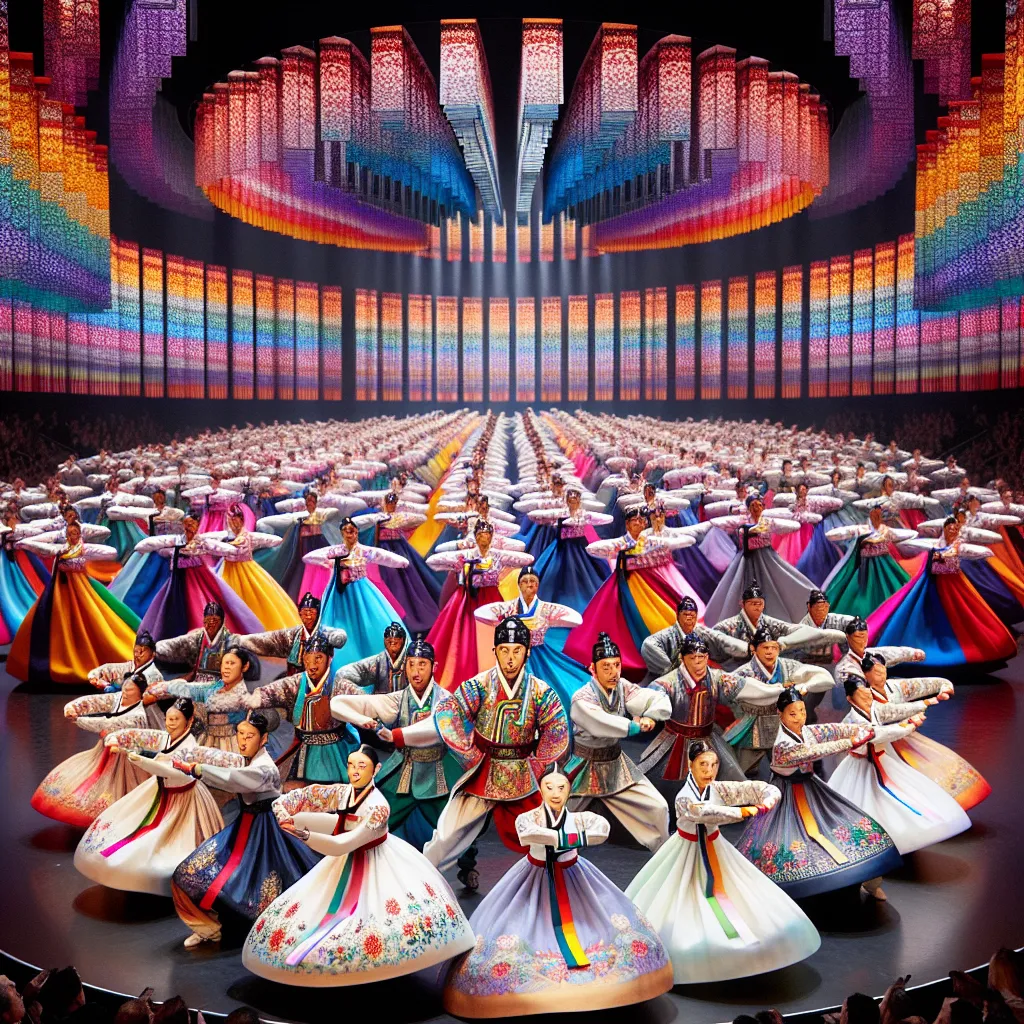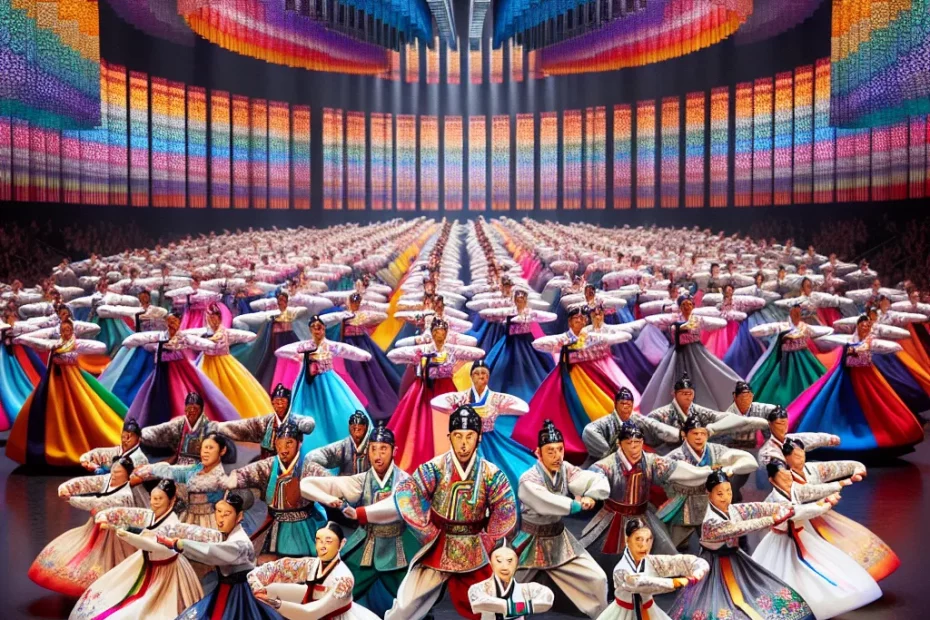Traditional Korean dance is a captivating art form that has been passed down through generations, reflecting the rich cultural heritage of Korea. Originating from ancient rituals and ceremonies, traditional Korean dance embodies grace, precision, and storytelling. The intricate movements and vibrant costumes of these dances serve as a visual feast for the eyes, captivating audiences with their beauty and elegance. As a significant aspect of Korean culture, traditional Korean dance plays a vital role in preserving and celebrating the country’s artistic traditions. Its importance cannot be overstated, as it serves as a link to the past and a source of national pride.

Origin and History of Traditional Korean Dance
Traditional Korean dance, known as “Choom” or “Salpuri,” has a rich history dating back centuries. This art form is deeply rooted in Korean culture and has been passed down through generations, evolving and adapting over time. 🌸
The Origins of Traditional Korean Dance
The origins of traditional Korean dance can be traced back to ancient shamanistic rituals and ceremonies. These dances were performed to honor the spirits, bring good fortune, and ward off evil. Over the years, Korean dance has incorporated elements of Confucianism, Buddhism, and Taoism, reflecting the diverse spiritual beliefs of the Korean people. 🙏
Three Kingdoms Period
During the Three Kingdoms period (57 BC – 668 AD), dance played a significant role in court rituals and ceremonies. The Silla Kingdom, in particular, was known for its elegant and graceful court dances, which were influenced by Chinese and Central Asian styles. These dances often featured intricate hand movements, flowing costumes, and symbolic gestures. 🏰
Goryeo Dynasty
In the Goryeo Dynasty (918–1392), Korean dance continued to flourish, with new styles and techniques emerging. The Goryeo court dances were characterized by their refined movements and elaborate costumes, reflecting the sophistication of the royal court. Dancers were highly trained and skilled, performing intricate choreography to the delight of the nobility. 💃
Joseon Dynasty
The Joseon Dynasty (1392–1897) saw further developments in traditional Korean dance, with the establishment of the “Seungmu” dance, a Buddhist ritual dance performed by monks. This dance form emphasized spiritual enlightenment and inner peace, incorporating elements of meditation and mindfulness. The Joseon court also patronized various dance forms, including the “Fan Dance” and the “Drum Dance,” which became popular among the common people. 🥁
Modern Revival
In modern times, traditional Korean dance has experienced a revival, with efforts to preserve and promote this cultural heritage. Organizations such as the National Gugak Center and the Korean Traditional Performing Arts Foundation have been instrumental in training new generations of dancers and preserving traditional dance forms. Today, traditional Korean dance continues to captivate audiences around the world with its beauty, grace, and cultural significance. 🌏
In conclusion, the origin and history of traditional Korean dance are deeply intertwined with the cultural, spiritual, and historical developments of Korea. From ancient shamanistic rituals to modern-day performances, Korean dance reflects the resilience and creativity of the Korean people, showcasing their unique artistic expression to the world. 💖
Key Characteristics of Traditional Korean Dances
Graceful and Fluid Movements
Traditional Korean dances are a vibrant and integral part of the country’s cultural heritage, embodying centuries of history and tradition. One key characteristic of traditional Korean dances is their graceful and fluid movements, which are often inspired by nature and everyday life. These movements are meticulously choreographed to convey specific emotions and stories, making each dance a visual masterpiece.
Colorful Hanbok Costumes
Another defining feature of traditional Korean dances is the use of colorful hanbok costumes, adorned with intricate embroidery and accessories. The costumes not only add to the visual appeal of the performance but also reflect the social status and personality of the dancers. The combination of elegant movements and elaborate costumes creates a mesmerizing spectacle that captivates audiences of all ages.
Role of Music
In traditional Korean dances, music plays a vital role in setting the mood and pace of the performance. The use of traditional instruments such as the janggu (hourglass-shaped drum) and the gayageum (zither) adds depth and richness to the dance, creating a harmonious blend of sight and sound. The rhythmic beats of the drums and the melodic tones of the strings enhance the overall experience, transporting the audience to a different time and place.
Unique Fan Dances
One of the most unique aspects of traditional Korean dances is the incorporation of fan dances, where dancers skillfully manipulate fans to create intricate patterns and movements. The fans symbolize various elements such as beauty, grace, and nature, adding layers of symbolism to the performance. The precision and synchronization required to execute these fan dances highlight the skill and dedication of the dancers.
Group Performances
Furthermore, traditional Korean dances often feature group performances, where dancers move in perfect unison to create a breathtaking display of coordination and harmony. The sense of unity and teamwork displayed in these group dances reflects the values of collectivism and community that are deeply rooted in Korean culture. Through synchronized movements and seamless transitions, the dancers convey a sense of solidarity and shared purpose.
In conclusion, traditional Korean dances are a celebration of artistry, culture, and tradition, showcasing the beauty and grace of Korean heritage. With their graceful movements, elaborate costumes, traditional music, fan dances, and group performances, traditional Korean dances continue to enchant audiences around the world, preserving a rich cultural legacy for future generations to appreciate and enjoy. 🌸🎶👘
Costumes and Props in Traditional Korean Dance
In the mesmerizing world of Traditional Korean Dance, costumes and props play a vital role in bringing the performances to life! The intricate designs of the costumes and the symbolic nature of the props add layers of meaning and beauty to each dance piece. Let’s delve into the fascinating details of the costumes and props used in Traditional Korean Dance! 💃🎎
Hanbok:
The traditional Korean attire, Hanbok, is a staple in Traditional Korean Dance. The flowing skirts and vibrant colors of Hanbok not only enhance the visual appeal of the dance but also reflect the rich cultural heritage of Korea. The graceful movements of the dancers in their Hanbok create a mesmerizing sight, captivating the audience with every step they take. 👘🌸
Norigae:
Norigae, the traditional Korean ornament, is often worn by female dancers as a decorative accessory. These ornate tassels, adorned with intricate designs and symbols, add a touch of elegance and sophistication to the costume. The gentle sway of the Norigae as the dancers move gracefully on stage adds a dynamic element to the performance, captivating the audience’s attention. ✨🌟
Buchaechum Fans:
One of the most iconic props in Traditional Korean Dance is the Buchaechum fan. These delicate fans, usually made of paper or silk, are used by dancers to create stunning visual effects during their performances. The rhythmic sound of the fans opening and closing, combined with the dancers’ precise movements, adds a sense of harmony and grace to the dance, leaving the audience in awe. 🌬️🎋
Janggu Drum:
The powerful beats of the Janggu drum resonate through the air, setting the rhythm for many traditional Korean dances. The Janggu drum, with its distinctive hourglass shape and vibrant colors, not only provides musical accompaniment but also serves as a visual focal point on stage. The synchronized movements of the dancers with the pulsating rhythms of the Janggu drum create a mesmerizing spectacle that truly embodies the spirit of Korean dance. 🥁🎶
In conclusion, the costumes and props in Traditional Korean Dance are not merely accessories but integral components that elevate the performances to a whole new level. The intricate details, symbolic meanings, and visual appeal of these costumes and props contribute to the rich tapestry of Korean dance, captivating audiences and preserving the cultural heritage for generations to come. Let the beauty and grace of Traditional Korean Dance continue to inspire and enchant us all! 🌺🇰🇷
Significance of Traditional Korean Dance in Korean Culture
Traditional Korean dance holds a profound significance in Korean culture, serving as a vibrant reflection of the country’s rich heritage and artistic traditions. 🌟
The Evolution of Traditional Korean Dance
With a history spanning centuries, traditional Korean dance has evolved into a captivating art form that embodies the essence of Korean identity and values. 💃 It plays a crucial role in preserving and celebrating the cultural heritage of Korea, showcasing the beauty and grace of Korean aesthetics through intricate movements and colorful costumes. 🎎
Spiritual Connection and Symbolism
One of the key aspects of traditional Korean dance is its deep connection to nature and the spiritual beliefs of the Korean people. 🌿 Dancers often draw inspiration from natural elements such as flowers, animals, and seasons, infusing their performances with a sense of harmony and respect for the environment. 🌸 This spiritual connection is evident in the graceful gestures and fluid motions that characterize traditional Korean dance, creating a mesmerizing visual experience for both performers and audiences alike. 🌌
Storytelling Through Dance
Moreover, traditional Korean dance serves as a means of storytelling, conveying narratives from Korean folklore, history, and mythology through symbolic movements and gestures. 📖 Each dance piece carries its own unique story and message, allowing viewers to immerse themselves in the rich tapestry of Korean cultural heritage. 🎭
Promoting Unity and Community Spirit
In addition to its cultural significance, traditional Korean dance plays a vital role in promoting unity and community spirit within Korean society. 💖 Dance performances are often a central part of traditional celebrations and ceremonies, bringing people together in joyous harmony and fostering a sense of shared cultural pride. 💫
Overall, traditional Korean dance stands as a testament to the enduring beauty and cultural richness of Korea, captivating audiences with its elegance, symbolism, and emotional depth. 🌟 Its significance in Korean culture cannot be overstated, as it continues to inspire and uplift generations of Koreans, both at home and around the world. 🌏
In conclusion, traditional Korean dance is not just a form of artistic expression; it is a living embodiment of Korean identity, values, and heritage, serving as a timeless symbol of cultural pride and unity. 🇰🇷 Let the graceful movements and enchanting rhythms of traditional Korean dance transport you to a world where tradition meets innovation, and history dances with the present. 💃✨
Traditional Korean dance is a rich and vibrant art form that has been passed down through generations, reflecting the beauty and grace of Korean culture. With its origins deeply rooted in the country’s history, traditional Korean dance showcases a unique blend of movements, music, and costumes that captivate audiences worldwide. The key characteristics of these dances, such as fluid movements, intricate gestures, and emotional storytelling, make them a true spectacle to behold. The costumes and props used in traditional Korean dance add an extra layer of visual appeal, enhancing the overall performance and creating a mesmerizing experience for viewers. Beyond just entertainment, traditional Korean dance holds significant cultural value, serving as a means of preserving and celebrating Korea’s heritage. Its importance in Korean culture cannot be understated, as it embodies the traditions, beliefs, and values of the Korean people. Embracing traditional Korean dance is not just a form of artistic expression, but a way to honor the country’s past and inspire future generations with its beauty and grace.
